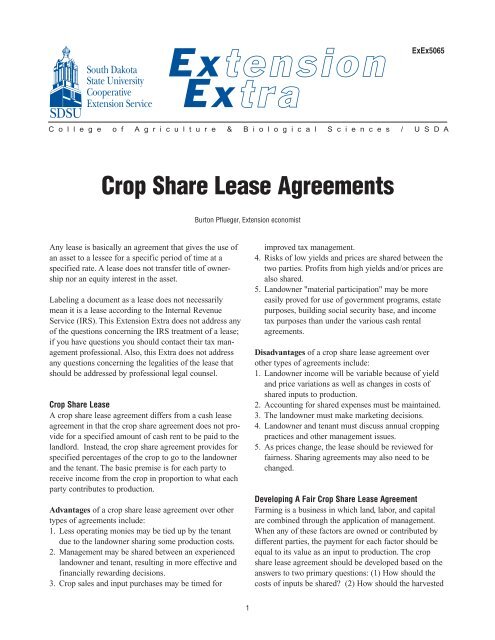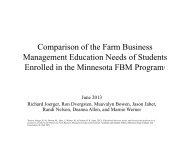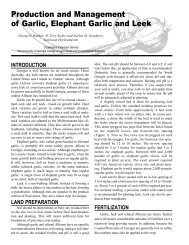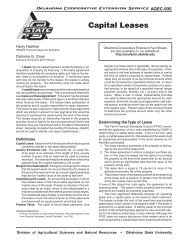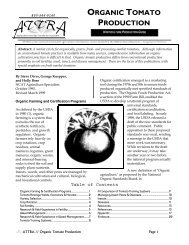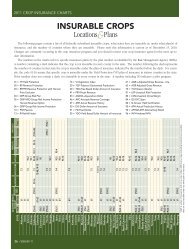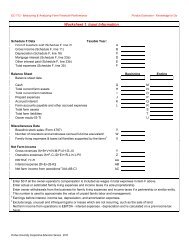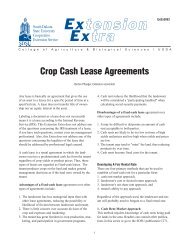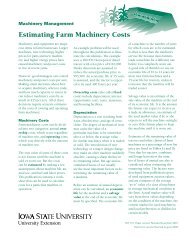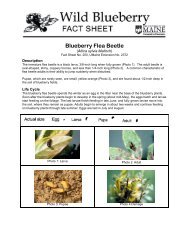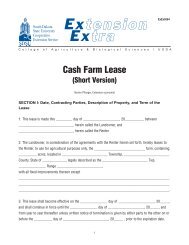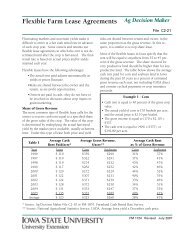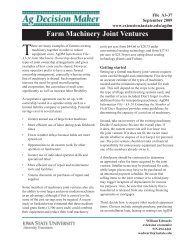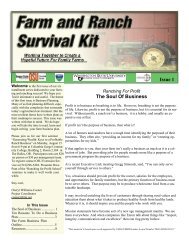Crop Share Lease Agreements - National Ag Risk Education Library
Crop Share Lease Agreements - National Ag Risk Education Library
Crop Share Lease Agreements - National Ag Risk Education Library
You also want an ePaper? Increase the reach of your titles
YUMPU automatically turns print PDFs into web optimized ePapers that Google loves.
ExEx5065<br />
C o l l e g e o f A g r i c u l t u r e & B i o l o g i c a l S c i e n c e s / U S D A<br />
<strong>Crop</strong> <strong>Share</strong> <strong>Lease</strong> <strong><strong>Ag</strong>reements</strong><br />
Burton Pflueger, Extension economist<br />
Any lease is basically an agreement that gives the use of<br />
an asset to a lessee for a specific period of time at a<br />
specified rate. A lease does not transfer title of ownership<br />
nor an equity interest in the asset.<br />
Labeling a document as a lease does not necessarily<br />
mean it is a lease according to the Internal Revenue<br />
Service (IRS). This Extension Extra does not address any<br />
of the questions concerning the IRS treatment of a lease;<br />
if you have questions you should contact their tax management<br />
professional. Also, this Extra does not address<br />
any questions concerning the legalities of the lease that<br />
should be addressed by professional legal counsel.<br />
<strong>Crop</strong> <strong>Share</strong> <strong>Lease</strong><br />
A crop share lease agreement differs from a cash lease<br />
agreement in that the crop share agreement does not provide<br />
for a specified amount of cash rent to be paid to the<br />
landlord. Instead, the crop share agreement provides for<br />
specified percentages of the crop to go to the landowner<br />
and the tenant. The basic premise is for each party to<br />
receive income from the crop in proportion to what each<br />
party contributes to production.<br />
Advantages of a crop share lease agreement over other<br />
types of agreements include:<br />
1. Less operating monies may be tied up by the tenant<br />
due to the landowner sharing some production costs.<br />
2. Management may be shared between an experienced<br />
landowner and tenant, resulting in more effective and<br />
financially rewarding decisions.<br />
3. <strong>Crop</strong> sales and input purchases may be timed for<br />
improved tax management.<br />
4. <strong>Risk</strong>s of low yields and prices are shared between the<br />
two parties. Profits from high yields and/or prices are<br />
also shared.<br />
5. Landowner "material participation" may be more<br />
easily proved for use of government programs, estate<br />
purposes, building social security base, and income<br />
tax purposes than under the various cash rental<br />
agreements.<br />
Disadvantages of a crop share lease agreement over<br />
other types of agreements include:<br />
1. Landowner income will be variable because of yield<br />
and price variations as well as changes in costs of<br />
shared inputs to production.<br />
2. Accounting for shared expenses must be maintained.<br />
3. The landowner must make marketing decisions.<br />
4. Landowner and tenant must discuss annual cropping<br />
practices and other management issues.<br />
5. As prices change, the lease should be reviewed for<br />
fairness. Sharing agreements may also need to be<br />
changed.<br />
Developing A Fair <strong>Crop</strong> <strong>Share</strong> <strong>Lease</strong> <strong>Ag</strong>reement<br />
Farming is a business in which land, labor, and capital<br />
are combined through the application of management.<br />
When any of these factors are owned or contributed by<br />
different parties, the payment for each factor should be<br />
equal to its value as an input to production. The crop<br />
share lease agreement should be developed based on the<br />
answers to two primary questions: (1) How should the<br />
costs of inputs be shared? (2) How should the harvested<br />
1
crop be shared to provide compensation for what the<br />
party has contributed to producing that crop?<br />
In a typical crop share lease agreement, the landowner<br />
contributes land and improvements, associated property<br />
expenses, and a certain share of the variable costs. The<br />
tenant usually contributes machinery, associated equipment<br />
expenses, and a certain share of the variable costs.<br />
Development of any final arrangements of the lease<br />
should be based on identifying all contributions of each<br />
party. Examples of how to use farm enterprise crop<br />
budgets to identify the contributions of the landlord and<br />
tenant and develop a crop share lease agreement are<br />
included at the end of this Extra.<br />
Valuing land is very difficult. Land costs represent a<br />
high proportion of total costs, and land usually appreciates<br />
in value over time. Land values should be based on<br />
fair market value for agricultural purposes with adjustments<br />
made for property taxes and insurance. Readers<br />
interested in current South Dakota agricultural land values<br />
can consult the SDSU publication C271, <strong>Ag</strong>ricultural<br />
Land Market Trends 1991-2006, South Dakota State<br />
University, which can be found on the internet at<br />
http://agbiopubs.sdstate.edu/articles/C271.pdf<br />
Buildings and improvements should be evaluated on<br />
their contribution to the farming operating. Sometimes<br />
cash rent is charged for buildings.<br />
Machinery and equipment normally have a multi-year<br />
life, so their cost should be spread over several years.<br />
Contributions are often based on depreciation, taxes,<br />
insurance, repairs, housing, and some return on the<br />
investment. Custom rates for anticipated operations are<br />
sometimes used when other machinery and equipment<br />
costs are unknown.<br />
Management is an important contribution to a successful<br />
lease arrangement. Its value is often a bargaining proposition<br />
between the involved parties. Management may be<br />
valued as a percentage of gross returns, rate per unit of<br />
yield, or percentage of all non-land costs.<br />
Variable expenses can be classified into three categories<br />
and should be shared according to their classification:<br />
yield increasing, true substitution, or both. Variable<br />
expenses which are yield increasing should be shared in<br />
the same percentage as the crop share. Such sharing<br />
encourages the parties to use the amount of input which<br />
will maximize net returns to the total operation.<br />
Substitution inputs are those that replace another input,<br />
such as chemical weed control replacing cultivation.<br />
Often new technologies make substitution inputs available<br />
to the production process. Substitution inputs may<br />
cause yields to increase and/or be used to replace a currently<br />
used input. True substitution items should be paid<br />
by the party responsible for the item in the original lease.<br />
Items that both cause yield increases and are true substitution<br />
items are good reasons for redeveloping the lease.<br />
Irrigation costs may involve special problems, so the<br />
landowner and tenant should be careful when agreeing<br />
who is paying for which irrigation expenses. While government<br />
program payments are usually shared in the<br />
same proportion as the crop, the tenant normally takes<br />
care of tillage, seeding, and weed control on "set-aside"<br />
acreage.<br />
Factors other than the relative contributions to production<br />
costs may affect rental agreements. <strong>Crop</strong> share percentages<br />
tend to become accepted as custom; hence, they are<br />
not easily changed. Also, local supply and demand conditions<br />
for rented land may affect the agreement.<br />
Put the <strong>Ag</strong>reement in Writing<br />
Both landlords and tenants are reminded that it is highly<br />
desirable to put the terms of a lease agreement in writing.<br />
A written lease agreement enhances understanding<br />
and communication between all involved parties, serves<br />
as a reminder of the terms originally agreed upon, and<br />
provides a valuable guide for the heirs if either the<br />
landowner or tenant dies.<br />
For some types of lease agreements, such as leases for<br />
longer than one year, South Dakota Codified Laws specify<br />
that the lease be written. Consult your attorney for<br />
guidance. Sample lease forms can be found elsewhere<br />
in this publication series.<br />
2
Example 1. <strong>Crop</strong> <strong>Share</strong> <strong>Lease</strong> Arrangement Calculations<br />
Example 2. <strong>Crop</strong> <strong>Share</strong> <strong>Lease</strong> Arrangement Calculations<br />
Soybeans<br />
Gross return<br />
Estimated yield 40<br />
Estimated selling price $ 5.00<br />
Value per acre $ 200.00<br />
Other income per acre<br />
Gross return per acre $ 200.00<br />
Landlord Tenant<br />
contribution contribution<br />
Direct costs per acre<br />
Seed $ 32.66 $ 32.66<br />
Fertilizer 17.50 17.50<br />
Herbicide 15.00 15.00<br />
Insecticide 5.00 5.00<br />
Fungicide 7.00 7.00<br />
<strong>Crop</strong> insurance 8.00 8.00<br />
Machinery costs (operating) 16.77 16.77<br />
Custom hire - -<br />
Drying<br />
Operating interest 4.63 4.63<br />
Other variable costs<br />
Total direct costs per acre $ 106.56 $106.56<br />
Machinery (ownership costs) $ 26.44 $ 26.44<br />
Land charge $ 55.00 $ 55.00<br />
Total costs per acre $ 188.00 $ 55.00 $133.00<br />
% total costs per acre 29.2554 70.74462<br />
For this example, the landlord and tenant may agree to split the harvested<br />
crop on a 70% to the tenant and 30% to the landlord just to<br />
simplify the calculations.<br />
Corn<br />
Gross return<br />
Estimated yield 140<br />
Estimated selling price $ 2.00<br />
Value per acre $280.00<br />
Other income per acre<br />
Gross return per acre $280.00<br />
Landlord Tenant<br />
contribution contribution<br />
Direct costs per acre<br />
Seed $ 50.00 $ 50.00<br />
Fertilizer 54.80 54.80<br />
Herbicide 20.00 20.00<br />
Insecticide<br />
Fungicide<br />
<strong>Crop</strong> insurance 10.00 10.00<br />
Machinery costs (operating) 22.55 22.55<br />
Custom hire<br />
Drying 8.75<br />
Operating interest 8.01 8.01<br />
Other variable costs<br />
Total direct costs per acre $174.11<br />
Total direct costs<br />
per acre less drying cost $165.36 $ 165.36<br />
Total direct costs per acre contributed<br />
Machinery<br />
(ownership costs) $ 30.12 $ 30.12<br />
Land charge $ 55.00 $ 55.00<br />
Total costs per acre $259.23<br />
Total costs per acre<br />
less drying $250.48 $ 55.00 $ 195.48<br />
% total costs per acre 21.9576 78.0424<br />
Drying 8.75 1.92 6.83<br />
$ 56.92 $ 202.31<br />
21.96 78.04<br />
In this particular example, drying costs are directly related to the<br />
amount of crop harvested. Landlord and tenant would share drying<br />
costs based on the share of the crop that each received. Thus the<br />
drying costs are removed from consideration until after the percentage<br />
of crop to each party has been determined.<br />
For this example, the landlord and tenant may agree to split the harvested<br />
crop onn 80% to the tenant and 20% to the landlord just to<br />
simplify the calculations.<br />
3
<strong>Crop</strong> <strong>Share</strong> <strong>Lease</strong> Arrangement Calculations Worksheet<br />
Gross return<br />
Estimated yield<br />
Estimated selling price<br />
Value per acre<br />
Other income per acre<br />
Gross return per acre<br />
<strong>Crop</strong><br />
_________ (bushels, tons, etc.)<br />
$ _________<br />
$ _________<br />
$ _________<br />
Total expense Landlord Tenant<br />
per acre, $ contribution, $ contribution, $<br />
Direct costs per acre<br />
Seed _________ _________ _________<br />
Fertilizer _________ _________ _________<br />
Herbicide _________ _________ _________<br />
Insecticide _________ _________ _________<br />
Fungicide _________ _________ _________<br />
<strong>Crop</strong> Insurance _________ _________ _________<br />
Machinery costs (operating) _________ _________ _________<br />
Custom hire _________ _________ _________<br />
Drying _________ _________ _________<br />
Operating interest _________ _________ _________<br />
Other variable costs _________ _________ _________<br />
Total direct costs per acre $ _________ $ _________ $ _________<br />
Machinery (ownership costs) _________ _________ _________<br />
Land charge _________ _________ _________<br />
Total costs per acre $ _________ $ _________ $ _________<br />
% of total costs per acre 100% _________ % _________ %<br />
Adapted for South Dakota from <strong>Crop</strong> <strong>Share</strong> <strong>Lease</strong> <strong><strong>Ag</strong>reements</strong>, <strong>Ag</strong>riculture & Business Management Notes, Section 4, No.4.6,Cooperative<br />
Extension, Colorado State University<br />
<strong>Crop</strong> enterprise budgets used in examples on page 3 can be found at http://econ.sdstate.edu/Extension/ in the Management Tools and Links<br />
section.<br />
South Dakota State University, South Dakota counties, and U.S. Department of <strong>Ag</strong>riculture cooperating. South Dakota State University is an Affirmative<br />
Action/Equal Opportunity Employer and offers all benefits, services, education, and employment opportunities without regard for race, color, creed, religion,<br />
national origin, ancestry, citizenship, age, gender, sexual orientation, disability, or Vietnam Era veteran status.<br />
EXEX5065. 2007. Access at http://agbiopubs.sdstate.edu/articles/ExEx2065.pdf.<br />
4


